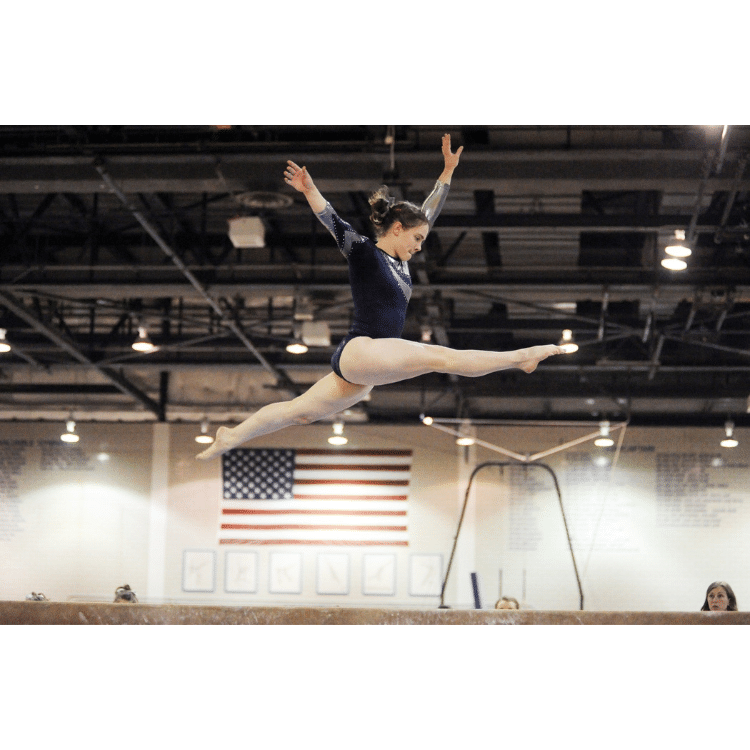This guide will explore the often confusing world of gymnastics levels, explaining the overview for Women’s Artistic gymnastics and the key skill requirements for each level.
Let’s take a deep dive into the latest gymnastics levels used by USAG for Women’s Artistic gymnastics.

Introduction to Gymnastics Levels
USAG uses a system of competition levels for Women’s Artistic gymnastics so that gymnasts can progress and advance in the sport. Each level has requirements on all four pieces of apparatus that gymnasts must meet in order to move up to the next level.
The four pieces of apparatus are Floor Exercise, Vault, Uneven Bars and Balance Beam.
Other programs such as Men’s Artistic and Rhythmic Gymnastics also use a development-level system but this article will focus just on the Women’s program. Click on the relevant links for an in-depth guide to each set of level requirements.
| Level | Type | Competitive Opportunities |
| 1, 2 and 3 | Development | In-gym, inter-club testing, some states have low-level events |
| 4 and 5 | Compulsory | Up to and including USAG State Championships |
| 6 and 7 | Optional | Up to and including USAG State Championships. Some Regional Championships. |
| 8 | Optional | Up to Regional Championships |
| 9 | Optional | Up to Eastern or Western Championships |
| 10 | Optional | Up to WDP National Championships |
- Compulsory levels consist of set routines that all gymnasts perform.
- Optional indicates that gymnasts can create their own routines.
Gymnastics Levels 1 to 3
Levels 1 to 3 are developmental levels designed to prepare young gymnasts for competitions when they are slightly older. Gymnasts will usually be taught the skills at these levels during recreational or pre-team classes without the pressure of going to competitions.
These basic skills are vitally important to master if a gymnast intends to become a competitive gymnast. They include skills such as:
- Forward Roll
- Backward Roll
- Cartwheel
- Handstand
- Pullover on Bar
- Scale on Beam
To find out more about the skill requirements on each level follow the links.
Gymnastics Levels 4 and 5
Level 4 is the first compulsory level meaning the gymnast has to perform a set routine on each piece of apparatus and meet a minimum mobility score in order to move up to level 5.
Level 4 is also the entry-level for those girls wishing to progress through all of the levels up to 10. In other words, you have to start at level 4 and cannot skip it.
Because all of the gymnasts are competing the same routines, the judges award a score based on the execution of the skills (how well they are performed). At this level, it becomes clear how well gymnasts have mastered the basic skills.

Level 5 is also a compulsory level and like level 4, competitive opportunities are organized up to and including the USA State Championships.
By level 5 gymnasts are required to perform the following skills on the floor:
- Round Off, Back Handspring, Back Tuck
- Front Tuck Somersault or Aerial
- Back Extension Roll
Gymnastics Levels 6 and 7
Levels 6 and 7 are optional levels meaning that gymnasts are now able to create their own routines. Because of this, harder skills are rewarded with higher difficulty scores and give gymnasts a greater chance of a higher total score. However, they must be able to perform harder skills with competence or they will lose marks on the execution.
USAG also has difficulty restrictions in place at levels 6 and 7 meaning gymnasts cannot include super difficult skills yet!
Level 6 is the only level that can be skipped. A gymnast can skip level 6 if their score at level 5 is high enough.
Gymnastics Levels 8 and 9
By levels 8 and 9 gymnasts can compete up to regional and Eastern or Western Championships so the standard is very high. Requirements become more complex and difficulty levels increase.
For example on bars girls will be required to change bars during the routine and perform a salto dismount. Beam routines are required to finish with a salto dismount as well.

Floor routines will have multiple acro series and saltos linked together.
Gymnastics Level 10
Level 10 is the final level of the Women’s Development Program and if a gymnast successfully completes level 10 they are able to try out for the Elite Program and ‘go pro.’
There are still minimum requirements on each piece but there are no upper limits on difficulty because it is the final level in the program. Level 10 culminates in the National WDP Championships.
Gymnasts must score a minimum of 34 AA (all around) to successfully pass level 10.
The Xcel Program
Introduced by USA Gymnastics during the early 2000s, the Xcel Program emerged as an alternative to the rigorous Junior Olympic program (now known as WDP), offering a more adaptable competitive platform for gymnasts. Over time, its appeal has surged, making it one of the predominant competition systems in the sport.

Both structures are separate entities however gymnasts can cross from one to another.
If you have a daughter with the option of taking either the Xcel or WDP pathways you should consider that it’s easier to move from WDP to Xcel than the other way round.
While certain coaches and establishments gravitate towards the Xcel initiative, others remain devoted to the conventional 10-level WDP approach, with some facilities offering both. A notable distinction between the Xcel and the traditional WDP systems lies in their competition objectives. Standard programs often prioritize victory and high scores, but the Xcel Program accentuates individual growth and milestones, providing an atmosphere with reduced stress, ideal for gymnasts keen on tracking their personal achievements.
Elite Level
After successfully passing level 10 in the Development Program comes the opportunity to ‘go pro’ in the elite levels. Only the top 2% of competitive gymnasts make it to this level.
An elite participant in the Women’s Program is characterized as any gymnast competing at the international level who initiates their first Optional event at a Classic contest. Such gymnasts are labeled as Elite and cannot revert to the Development Program within the same competitive Elite year.
The Elite Program aims to foster competitive opportunities for athletes with National Team ambitions. Selections for both Senior and Junior National Teams are made annually from the U.S. Championships. These selected gymnasts then stand as representatives for the U.S. in global events. Throughout the year, various clinics, training camps, and competitions at both regional and national Elite levels are organized.
These events are meant to impart knowledge and cultivate advanced technical skills for both athletes and their coaches within the Elite framework. Coaches, believing their athlete is prepared for international Elite competitions, can forward videos to the High-Performance Team at USAG.
TOPS Program
An alternative route into the Elite levels is via the Talent Opportunity Program (TOPS) Testing program. TOPS is aimed at 8 to 10-year-old gymnasts and comprises of rigorous testing of physical abilities.
Some of the testing is focused on skills whilst other sections focus on the strength and conditioning of the gymnast. By identifying the physically strongest girls at a young age, USAG is able to provide an intense training platform that eventually leads to the elite level.
However, the TOPS program is intense and only suits girls with the strongest mental attitude as well as the physical attributes.
Final Thoughts
This guide provides a high-level overview of the Women’s Artistic Program in the USA. Be sure to take a closer look at the skill requirements for each level as these guides also include age requirements and the score requirements needed to move up.
Sources:
